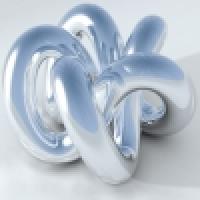
Maths in a minute: Countable infinities
An infinite set is called countable if you can count it. In other words, it's called countable if you can put its members into one-to-one correspondence with the natural numbers 1, 2, 3, ... . For example, a bag with infinitely many apples would be a countable infinity because (given an infinite amount of time) you can label the apples 1, 2, 3, etc.
Two countably infinite sets A and B are considered to have the same "size" (or cardinality) because you can pair each element in A with one and only one element in B so that no elements in either set are left over. This idea seems to make sense, but it has some funny consequences. For example, the even numbers are a countable infinity because you can link the number 2 to the number 1, the number 4 to 2, the number 6 to 3 and so on. So if you consider the totality of even numbers (not just a finite collection) then there are just as many of them as natural numbers, even though intuitively you'd think there should only be half as many.
Something similar goes for the rational numbers (all the numbers you can write as fractions). You can list them as follows: first write down all the fractions whose denominator and numerator add up to 2, then list all the ones where the sum comes to 3, then 4, etc. This is an unfailing recipe to list all the rationals, and once they are listed you can label them by the natural numbers 1, 2, 3, ... . So there are just as many rationals as natural numbers, which again seems a bit odd because you'd think that there should be a lot more of them.
It was Galileo who first noticed these funny results and they put him off thinking about infinity. Later on the mathematician Georg Cantor revisited the idea. In fact, Cantor came up with a whole hierarchy of infinities, one "bigger" than the other, of which the countable infinity is the smallest. His ideas were controversial at first, but have now become an accepted part of pure mathematics.
To find out more about uncountable infinities, see Counting numbers. You can find out more about infinity in general in our collection of articles on infinity.
math.nights
To Arabic: https://goo.gl/rSCz6F
Leslie.Green
This "orthodox" maths is not a good approach to the subject since it actually stops you counting correctly. The ultimate foolishnes is taking a finite set of counting numbers, O(N), and doing a one-to-one mapping (bijection) to the corresponding set of rational numbers, O(N²). As you consistently increase N to infinity it is obvious that the mapping gets worse and worse, and yet somehow we are asked to believe that infinity somehow makes it all ok. This is not the correct way of dealing with divergent series.
Here is a little problem designed to restart the thinking process: https://www.aplusclick.org/t.htm?q=7897
And then it is time to re-learn the subject: http://lesliegreen.byethost3.com/articles/infinities.pdf
Leslie.Green
It's obviously not "easy" since nobody has done so in the last 100 years. However, once you are shown how to do it, the result is easy.
http://lesliegreen.byethost3.com/articles/continuum.pdf
Yoyo Yiu
Your proof only shows that all number with FINITE decimal digits (a subset of rational numbers) are enumerable (countable).
Leslie.Green
It is a misconception to think that the list is finite because it is indexed by a natural number. The natural numbers are “closed under addition”. It means that you can (for example) add 1 indefinitely, and you still have a natural number.
Each block in the enumeration gives an extra digit. The list is not finite, and so the number of digits is also not finite.
According to a standard text: Theorem 14.3: A set is countably infinite if and only if its elements can be arranged in an infinite list a1, a2, a3, a4, … Book of Proof by Richard Hammack. ed 3.2
The point is that this method of bijection is not a valid counting method.
See: The Misuse of Bijection when Comparing Infinite Sets, (2022), Green. L.O. (https://www.researchgate.net/publication/360504965)